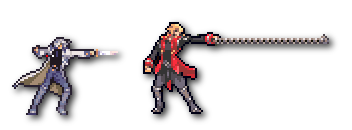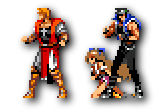
It all started...
 (note: this is a reprint and minor rewrite of a segment that appeared in my book)
(note: this is a reprint and minor rewrite of a segment that appeared in my book) Konami's
Castlevania is an unusual game. It's incredibly popular in the Western world, but is a consistently poor seller in its native Japan. Despite this it is still a mainstay of Konami's game lineup, and has so far graced more than ten different game systems. Except for a few unpopular attempts at 3D the series is still in fabulous 2D.
For most of its run, the Castlevania protagonist has used a whip as the main weapon. Only a few games have strayed from this, but even when a Castlevania game offered a new weapon there was usally a whip that could be equipped, or a whip-wielding alternate character.
The series started on the Nintendo Entertainment System hardware, and has appeared on most systems since then. The only Nintendo platforms since the NES without a Castlevania were the Virtual Boy and GameCube. The series has graced the NES, Super NES, Genesis (MegaDrive), MSX, Amiga, Arcade, X68000, PS1, PS2, N64, GameBoy, GBA, and DS.
The main character frequently changed, and in some instances a female took the lead. The artists at Konami were very successful in creating characters from one hardware generation to the next, maintaining the same spirit from the original games while taking advantage of the new hardware's abilities.
Castlevania Sprite History
Below is every pre-DS 2D castlevania main character released from 1986 to 2003. They're divided into six distinct groups, more or less divided by hardware era. In addition there are the ugly-vanias, the ports to platforms that might better have been left ignored.
The very beginnings, 1986-1998
During the NES' reign the hero changed very little, only a handful of pixels in the shoulders changing from one sprite to the next. It could be said that Konami had maxed out the hardware from the start, using all four available colours and gaining only few pixels in size by the time the third game was released.

Castlevania on the NES
From Left:
Castlevania (1986)
Castlevania 2: Simon's Quest (1987)
Castlevania 3: Dracula's Curse (1990)
The original GameBoy presented serious challenges for all pixel artists, but Konami's artists rose to the task. The heroes in all three GameBoy games retained their whip toting appearance, even while inexplicably becoming left handed. One can't help but wonder what Konami's artists were thinking when, in 1998, two years after the release of the Playstation and Saturn, they were asked to produce another GameBoy iteration, with all the resolution, colour and memory limitations that entails.

Castlevania on the GameBoy
From Left:
Castlevania Adventure (1989)
Castlevania 2: Belmont's Revenge (1991)
Castlevania Legends (1998)
The 16-bit era, 1988-1994
After the limits imposed by the NES and GameBoy, a terribly ugly arcade foray and a faltering SuperNES outing, Konami started hitting their stride. The 1993 release of Castlevania on the X68000, a super-powerful Japanese computer from Sharp, was better than its predecessors, and then came the PC Engine version, which became the gold standard for many years. The same sprite used on the PC Engine was recycled in the second Super NES game, and the Playstation and Saturn sequels. Then in 1994 Konami fell from their tree: the MegaDrive version is inexcusably garish, moreso than the arcade version years before.

Haunted Castle, Arcade (1988)
Castlevania IV, SuperNES (1991)

Akumajo Dracula, X68000 (1993)
Dracula X: Rondo of Blood, PC Engine (1993)
Castlevania: Bloodlines, MegaDrive (1994)
The Golden Age, 1997-8
For a brief moment Konami blew out all the stops with the Playstation and Saturn versions (they were visually identical, but released a year apart). The new 32-bit sprites were fluidly animated, with billowing capes and glowing motion trails. The new protagonist was joined by the old: the original whip-weilding Richter was a hidden bonus, and was the last appearance of the PC Engine sprite.

Castlevania: Symphony of the Night:
Left Richter: Saturn
Right Richter: Playstation
Alucard: Playstation & Saturn (1997 & 1998)
Subsequent to but still related to this golden age, there were several sprite updates. The Saturn version of Symphony had a remade Richter sprite (above), and the Playstation re-release of the X68000 Dracula included another remade sprite, shown below.

Original (left) and remake, Castlevania Chronicles, PSX (2001)
The GameBoy Advance Age, 2001-2003
The next major change in the graphic appearance was with the launch of the GameBoy Advance. Castlevania: Circle of the Moon was released alongside the system, and it was immediately slammed in the gaming press for being too dark to play on the GBA's appalling screen. The next GBA release went for the other extream, and featured a larger, brighter, and strangely less detailed protagonist, with a weird blue outline and odd cel-shaded appearance. As if realizing their mistake, Konami found a comfortable middle ground for the final GBA outing. Once again they forgot to give him a whip.

Castlevania on the GameBoy Advance
Castlevania: Circle of the Moon (2001)
Castlevania: Harmony of Dissonance (2002)
Castlevania: Aria of Sorrow (2003)
Left to Right
The Nintendo DS Age, 2001-2003
It's a sad fact that the Nintendo DS is becoming the last bastion of good pixel art. While most new mobile phones have better screens, the DS is far better suited for gaming, and has a screen large enough to actually appreciate the graphics. Konami's keeping with the effeminate Victorian theme, eschewing the whip-wielding muscleman for fancy fops in frilly frocks. Oh, for the manly men of yore!
The attack pattern also changed. Starting with Alucard in Symphony of the Night Konami's protagonists started using a back-handed attack, meaning that the characters were now facing the player instead of away from them. It's a subtle, but interesting change, and it's curious that they didn't do this for the first two GBA releases, but did again with the third, and two DS outings. The old GameBoy games might be considered a half-way, side-long pose.

Castlevania on the Nintendo DS
Castlevania: Dawn of Sorrow (2005)
Castlevania: Portrait of Ruin (2006)
Left to Right
The Forgotten Days (1986, 1990)
Unbeknownst to most game players in the West, four computers received Castlevania ports. Konami themselves created the MSX and Commodore 64 versions, while the Amiga version (and probably PC as well) was licensed to Novatrade. The Konami-made conversions were the better of the four. The MSX sprite is very nearly identical to the NES version (but for a handful of pixels and a more detailed whip), and the C64 sprite was about as good as the hardware could get. The Amiga version suffered though. A lot. This misshapen dwarf retains little of the manly good looks his brethren enjoyed. The DOS protagonist was even worse. While it appears the same Amiga sprite was used, it has fewer colours and a bizarrely pink whip.

Clockwise from Top Left
Vampire Killer, MSX (1986)
Castlevania, Amiga (1990)
Castlevania, DOS (1990)
Castlevania, C64 (1990)
The Lost (xxxx)
Konami anounced, showed off, but never released a version of Castlevania for Sega's short-lived 32X. Assuming the following screenshot is real, it's more or less all there is to show of this effort. It has been said that the assets created for this game were used for Symphony of the Night.

Castlevania for Sega's 32X (unreleased)
The Ugly Darkling
There was an unreleased Castlevania: Symphony of the Night for Tiger's ill-fated Game.com handheld. The sprites were four-colour versions of the Playstation/Saturn version, and Alucard, poor spawn of Dracula, looks downright awful.

Castlevania: Symphony of the Night, Game.com (unreleased)
Lawrence.
Addenda
Several people have raised interesting points about this article:
Did you have to use the drop-shadow on every sprite? Yes, I did. For two reasons: 1. I like the effect, I feel it elevates the sprite from the page. 2. Many sprites have white or light-coloured elements which disappear against the white page background.
You forgot the DS games. I didn't
forget. Unfortunately there are no DS emulators that work with Castlevania, and most of the screenshots online are JPGs, which are useless for the purposes of this comparison. Of the two DS games above, one is from a JPG, the other from a lovely PNG, both from
the Castlevania Dungeon.
You missed the C64 version! I did! I'll be adding it as soon as I can. The PC version was also missing, but this has been rectified!
A "faltering SuperNES outing"!? WTFzOMFG!! Yeah, faltering. It was a game that struggled to really hit its stride. The graphics were often muddy, and the whip action was not as tight as in other games. Yes, musically it was awesome, but I don't think it stands against Dracula X or SotN, despite its advancements over the X68000 Dracula. Too many levels were tech demos, and perhaps recognizing this Konami never reused techniques like the rotating tubes and levels.
Credits: DOS version screenshot snagged from
Abandonia.
Chronicles remake & DS sprites snagged from
the Castlevania Dungeon.
Saturn Richter was snagged from
MrP's Castlevania Realm.
Special thanks to Frogacuda, Johnny Undaunted and everyone else who offered suggestions, made corrections or told me I was full of shit.
Originally written Nov. 2006, updated most recently April 2013.
 (note: this is a reprint and minor rewrite of a segment that appeared in my book)
(note: this is a reprint and minor rewrite of a segment that appeared in my book)










